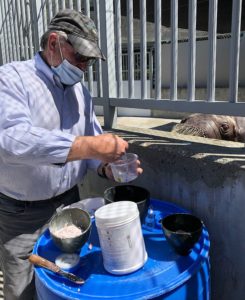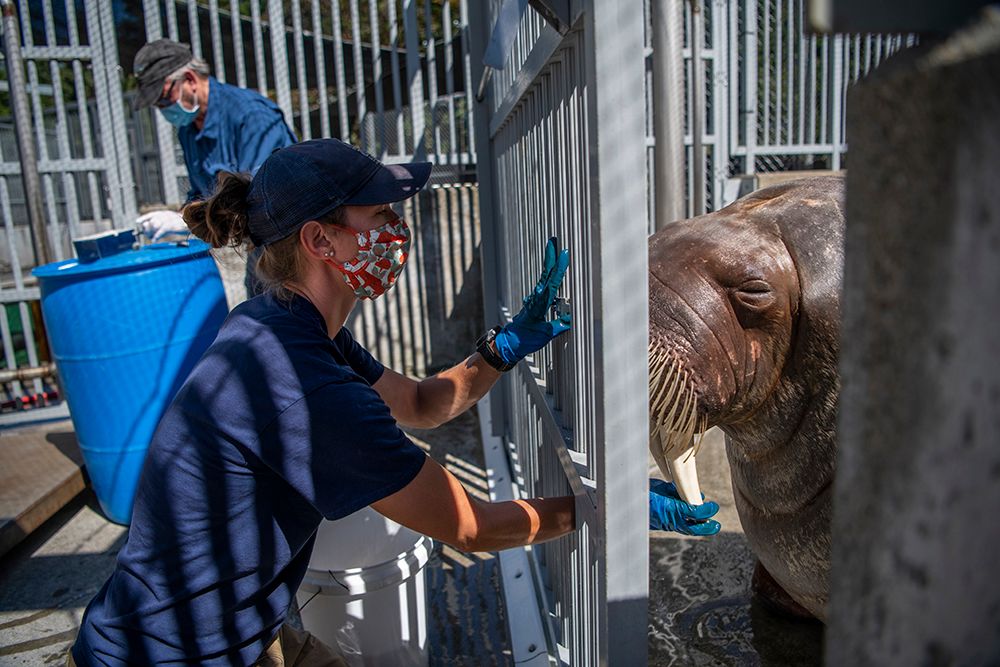Pakak the walrus has been busy visiting with the dentist. He was recently fitted for a new tusk crown.

Walruses in zoos receive regular veterinary care, including dentist checkups. Walrus tusks don’t have a hard outer enamel layer like human teeth. So the tips of many walrus tusks have metal crowns placed on them to prevent the tusks from becoming worn down and susceptible to bacterial infection.
Walruses in the wild sometimes get tusk infections through normal activities like foraging, sparring and moving on land.
“Because walruses naturally rub their tusks, the protective layers surrounding their pulp cavity can get worn down and allow bacteria to enter the tooth and cause infection and pain, which can have serious health side effects,” said Point Defiance Zoo Head Veterinarian Dr. Karen Wolf.
Walruses in human care often receive crowns to protect their tusks. These crowns need to be replaced throughout the walrus’s life.
“It’s kind of like wearing a mouth guard for sports or night guard if you grind your teeth,” said Marine Mammal Curator Malia Somerville.
Taking Impressions
Walrus tusks are continually growing so they regularly outgrow their caps, which then loosen and fall off. Recently, one of Pakak’s crowns fell off so it was time to take an impression for a new one!
Keeper Sheriden Ploof trained Pakak to sit still long enough for her to take an impression. He needed to be comfortable for about one minute with a playdough-like substance around the tip of his tusk. Sheriden and Pakak worked over several weeks to build up trust and patience until eventually Pakak remained still long enough for Sheriden to make a mold using the actual dental impression material prepared by the consulting dentist. Of course, Pakak was rewarded with some yummy fish!

After the mold set, the dentist delivered it to the dental laboratory so they could manufacture the custom-made metal crown. Once it was ready to go, the crown was brought back to the Zoo. With the help of the Zoo veterinarian and keepers, the crown was placed securely on Pakak’s tusk.
“Pakak did very well and was patient with us,” said Dr. Wolf.
You can now see Pakak and Mitik swimming in their Rocky Shores habitat with crowns on both of their tusks!
Protecting Walruses in the Wild
Aside from the possibility of tusk infection, wild walruses face many other threats. Climate change is their biggest threat. As the Arctic sea ice melts, they’re forced to forage in shallow water where the food quickly runs out, leading to conflict. They also use the sea ice to rest, give birth to their young, and as a form of transportation. The smaller amount of sea ice is also causing walruses to gather in larger groups, sometimes resulting in deaths from stampedes.
You can help walruses and other Arctic animals by turning off your engine when waiting in your car for 30 seconds or more, skipping the drive-through line, planting or caring for a tree and shopping local. You also can donate to The Zoo Society’s Dr. Holly Reed Wildlife Conservation Fund, which supports critical walrus research and helps the Zoo help protect wildlife and wild places at home and around the world.